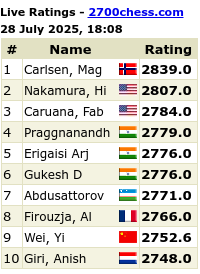1.d4 Topalov, very expectedly, decided to hit on the same spot again.
1...d5 And this time Anands opts for a solid Slav, rather than a crazy Grunfeld.
2.c4 c6 3.Nf3 Nf6 4.Nc3 dxc4 Not the Moscow Line, which is a trademark of Anand.
5.a4 Bf5 6.Ne5 e6 7.f3 c5 8.e4 Bg6 Anand chooses the solid variation that Kramnik played against Topalov in their match in Elista. It is actually funny that Anand seem to follow what Kramnik played back then in 2006 – yesterday Catalan, today this rock solid but passive Slav.
9.Be3 cxd4 10.Qxd4 Qxd4 11.Bxd4 Nfd7! 12.Nxd7 Nxd7 13.Bxc4 a6 [13...Rc8 is another line, avoiding the 14.Rc1 idea, deserves attention. 14.Ba2 (14.Bb5!? ) 14...a6 ]
14.Rc1
14...Rg8!N A very logical move, which turned out to be a novelty. Now Black plans Bd6, Ke7, f6, Rgc8, Bg8, etc. White actually has to hurry up and do something against it, which is not easy, since his knight on c3 is misplaced. [Earlier people played 14...Rc8?! but then White gets a big advantage with 15.Ne2! Rg8 16.h4 h6 17.Kf2 the point being that 17...Be7? is losing to (17...Rc6 18.b4! ) 18.h5 Bh7 19.Bxe6! Rxc1 20.Bxd7+! ]
15.h4 h6 16.Ke2 [16.Kf2 Makes sense having the e2 square for the knight. But Topalov had another knight route in mind.]
16...Bd6 17.h5 Bh7 Here I was actually wondering if Topalov had prepared anything at all. White seems to be unable to stop the black development... But the next move of Topalov proved that I was wrong!
18.a5! This move seemed a little bit strange to me at first sight, since I couldn't figure out the white plan after Bb4, as well as the simple Ke7 and so on. However Topalov had an answer to both.
18...Ke7 Safe and solid, Anand just concentrates on his plan. [18...Bb4 is challenging but dangerous. White has three interesting possibilities: 19.Nb5!? is the most spectacular, and in all the following complications Black is in danger, though maybe he holds with precise play. There are a lot of possible lines, but I just give main: (19.Na4! Bxa5 20.Nc5 is the simplest. The black king is stuck in the centre, but Black is still solid and he has an extra pawn.; 19.Rhd1!? Bxa5 20.Nb5! axb5 21.Bxb5 here black seems OK after 21...Ke7 22.Bc3! Nb8! 23.Ra1! Bxc3 24.Rxa8 Bxb2 25.Ra7 Kf6 26.Rxb7 g5 27.hxg6 Bxg6 28.Ke3 e5 with a dead knight, but counterplay) 19...axb5 20.Bxb5 Rxa5 21.Bxd7+ Kxd7 22.Rhd1 Rb5 23.Be5+ (23.Bb6+!? Ke7 24.Rc7+ Kf6 25.Rxb7 Bc5 26.Bd8+ Rxd8 27.Rxb5 Bd4 28.b4 g6! with an unclear position.) 23...Ke7 24.Rc7+ Ke8 25.Rc8+ Ke7 26.Rc7+= ]
19.Na4 f6 just following the plan. [19...Rac8 was clever, trying to avoid b4, but after let's say 20.Bd3! White keeps up the pressure, for example 20...f6 21.Bb1 Rgd8 22.Nb6! ]
20.b4! White does something active quickly, before Black manages to get all his pieces into play (Rgc8, Bg8-f7) [20.Nb6 Doesn't give White anything, as long as Black is a very little bit careful. 20...Nxb6 21.Bxb6 Rgc8 22.Rhd1 Rc6 (22...Bg8 23.b3 Bf7? 24.Rd3! Bxh5 25.Rcd1 Rc6 26.Rxd6! Rxd6 27.Bc5 Rad8 28.Ke3 ) 23.b3 Rac8 24.Rd3 Bb4! 25.Rcd1 Rd6 equalizing]
20...Rgc8 Again, Anand doesn't get distracted by anything, he simply makes his moves. [20...Bxb4 objectively, was also too risky 21.Rb1 Bxa5 22.Rxb7 (22.Nc5!? b5 23.Bxe6 Nxc5 24.Bxg8 Bxg8 25.Bxc5+ Kd7 and Black has compensation, but White has the exchange.) 22...Rgb8 23.Bc5+ (23.Rhb1 Rxb7 24.Rxb7 Kd6! ) 23...Ke8 24.Rxb8+ Rxb8 25.Bd6 with an unclear position, but White should be better.]
21.Bc5 Actually I was expecting a different piece to be sent to this square. [21.Nc5!? is interesting, but probably Black holds here as well. 21...Bxc5 looks dangerous, but in fact it may be good (21...Nxc5 Is most logical, but white keeps winning chances after 22.bxc5 Bxc5 23.Bxe6! Kxe6 24.Bxc5 ; 21...Rc7!? ) 22.bxc5 Nxc5 Now I didn't find a way for White to achieve anything, for instance (22...Rc7+/= ) 23.Ba2 Nd7 24.Bb2 Bg8 25.Ba3+ Ke8 26.Rhd1 b5! 27.axb6 Nxb6 28.Bb3 Rxc1 29.Rxc1 Rc8 30.Rxc8+ Nxc8 31.Bc4 ]
21...Bxc5 22.bxc5 Rc7 [22...Rc6 made sense, trying to win a tempo, which will be usedul in case White plays Nb6, but here White goes 23.Rhd1! with the idea 23...Rac8 24.Rxd7+! Kxd7 25.Nb6+ Rxb6 26.cxb6 Bg8 27.e5! with an edge.]
23.Nb6 Rd8 24.Nxd7 Simple and safe, but from Topalov I expected a move like Bd5! [24.Bd5!? is beautiful and tricky. Black shouldn't take anything now, not d5, not c5 and not b6, but play 24...Ne5!? (24...Nxc5 25.Bxb7! ; 24...Nxb6 25.axb6 Rcd7 26.Bc4! ; 24...Nb8!? ) 25.f4 Nd3! 26.Kxd3 exd5 27.f5! dxe4+ 28.Kxe4 Ke8! with equality]
24...Rdxd7 25.Bd3 Here I actually realized what Topalov was planning. He wants to play c6, change the pawn to a b-pawn, and try to attack the remaining weak a6 pawn. The position is quite unpleasant for Black.
25...Bg8 [Anand should have perhaps been more activebut perhaps he saw his was safer. 25...f5!? This was advocated by Garry Kasparov, who was watching the game from a hotel room in Oslo.; 25...Rd4!? seemed to force a draw, but White has a resource 26.c6! Ra4 27.Rb1! Ra2+ 28.Ke3 bxc6 29.Ra1 Rxg2 30.Bxa6 Still keeping some chances.]
26.c6 Rd6 27.cxb7 Rxb7 28.Rc3 Bf7
29.Ke3 [29.Rhc1! immediately also made sense and was probably a better try, since it is risky to take the pawn. 29...Bxh5 (29...Be8! 30.Rc7+ Rd7 is holding 31.Rxd7+ Bxd7 32.Bxa6 Ra7 ) 30.Rc7+ Rxc7 31.Rxc7+ Rd7 32.Rc8 ]
29...Be8 30.g4 [30.Rhc1!? wouldn't change much after 30...Bd7! ]
30...e5 31.Rhc1 Bd7 32.Rc5 Bb5! The final touch. Now Black's last problem, the pawn on a6, is gone, and it is time to agree to a draw. It is funny that Anand equalized today without any of his pieces being on the opponent's half of the board.
33.Bxb5 axb5 34.Rb1 b4 35.Rb3 Ra6 36.Kd3 Rba7 37.Rxb4 Rxa5 38.Rxa5 Rxa5 39.Rb7+ Kf8 40.Ke2 Ra2+ 41.Ke3 Ra3+ 42.Kf2 Ra2+ 43.Ke3 Ra3+ 44.Kf2 Ra2+ 45.Ke3 Ra3+ 46.Kf2 1/2-1/2
[Analysis by GM Giri on Chessbase]
Tuesday, April 27, 2010
Subscribe to:
Post Comments (Atom)

No comments:
Post a Comment